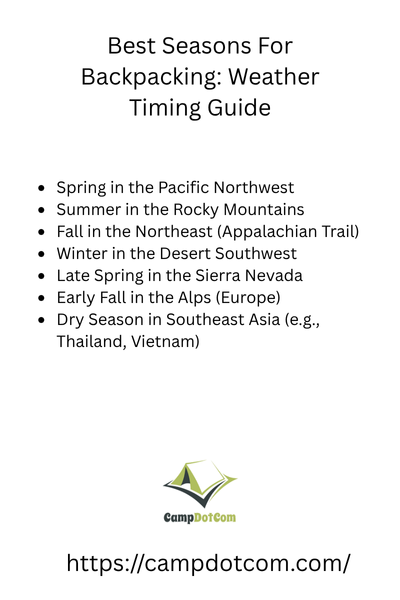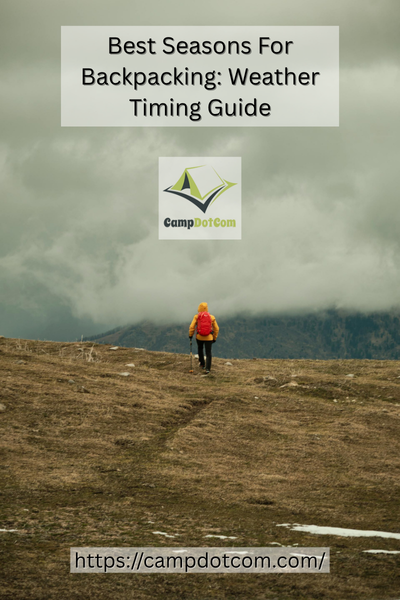If you’ve ever set off on a backpacking trip only to be met with relentless rain, unbearable heat, or unexpected snow, you know that timing is everything. That’s why understanding the best seasons for backpacking can make or break your adventure.
Let’s chat about when to hit the trails and what to expect so you can have the best trip possible.
Read More About Best Seasons for Backpacking

Spring: Fresh Blooms and Unpredictable Weather
Ah, spring—the season of new beginnings. It’s tempting to grab your gear and hit the trails as soon as the snow starts melting. But before you do, keep in mind that spring backpacking can be a mixed bag.
As an Amazon Associate, I earn from qualifying purchases. Some of the links in this article are affiliate links. This means that, at zero cost to you, I will earn an affiliate commission if you click through the link and finalize a purchase.
More Things to Know About Best Seasons for Backpacking

I’ve been there—packing light because the forecast looked warm, only to wake up to a surprise snowstorm in the Rockies. Lesson learned: spring weather is unpredictable!
Trails at lower elevations tend to be muddy, and high-altitude hikes might still be covered in snow. But if you plan well, spring can be magical. Think wildflowers, fewer crowds, and crisp morning air.
Best Spring Backpacking Destinations:
- The Appalachian Trail (lower elevations)
- The Grand Canyon (before summer heat kicks in)
- California’s Lost Coast (perfect before summer crowds arrive)
Summer: Long Days and Crowded Trails
Summer is the peak season for backpacking, and for good reason. The days are long, the trails are mostly snow-free, and you don’t have to worry about freezing at night. But let’s be real—summer has its downsides too.
First off, crowds. If you’re dreaming of solitude, summer might test your patience. National parks and famous trails get packed, and some require permits months in advance.Also, heat can be brutal in lower elevations. Ever tried backpacking in the desert in July?
Yeah, I don’t recommend it unless you’re part camel.That said, if you head to higher elevations, summer is prime time.
The Rockies, the Sierra Nevada, and the Cascades are stunning, with wildflowers in full bloom and minimal risk of hypothermia. Just pack bug spray—mosquitoes can be relentless.
Best Summer Backpacking Destinations:
- The Pacific Crest Trail (alpine sections)
- The Colorado Trail (snow-free and gorgeous)
- The Canadian Rockies (Banff and Jasper—wow!)
Fall: The Sweet Spot for Backpacking
If I had to pick my favorite season for backpacking, it would be fall. Cooler temperatures, fewer bugs, and those jaw dropping fall colors? Yes please.
Fall gives you the best of both worlds. Warm enough for comfortable hiking but not so hot that you feel like you are melting.
Plus, the crowds thin out after Labor Day. Ever had an entire alpine lake to yourself? It is a fall thing.
The only downside is the shorter days. You will need to start your hikes earlier to avoid setting up camp in the dark.
And at higher elevations, winter can show up unexpectedly, so keep an eye on the forecast.
Best Fall Backpacking Destinations:
- The White Mountains (New Hampshire’s foliage is unreal!)
- The Smoky Mountains (less humidity, better views)
- The Sierra Nevada (before the first snowfall)
Winter: Quiet, Challenging, and Rewarding
Winter backpacking is not for the faint of heart, but it is also one of the most rewarding experiences you can have. Imagine crisp snow covered trails, total solitude, and no bugs. Sounds dreamy, right?
Of course, winter brings serious challenges like freezing temperatures, deep snow, and the need for extra gear. If you are new to winter backpacking, start small. Try an overnight trip in a mild climate before jumping into serious alpine adventures.
I will never forget my first real winter trek. My water bottle froze solid overnight because I did not think to keep it in my sleeping bag, and my bag was almost not warm enough. But waking up to a sunrise over a snow covered valley? Absolutely worth it.
Best Winter Backpacking Destinations:
- The Arizona Trail (mild temperatures, beautiful desert landscapes)
- Big Bend National Park (perfect for avoiding summer heat)
- The Southern Appalachian Mountains (moderate winters)
Picking the Best Season for Your Trip
So what is the best season for backpacking? Well, that depends on where you are headed and what kind of adventure you are looking for.
Love warm weather? Try summer in the mountains. Prefer peace and quiet? Fall might be your best friend. Looking for a real challenge? Winter could surprise you. No matter when you go, always be prepared. Check the weather, pack what you need, and make sure someone knows your plans. Most of all, enjoy the journey.
Backpacking is not just about where you end up. It is about everything you see and feel along the way.
Do you have a favorite season for backpacking? Share it in the comments. I would love to hear about your go to spots.
